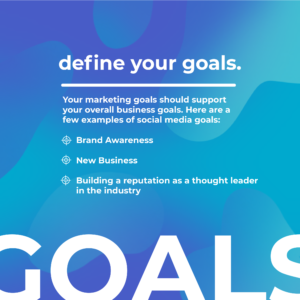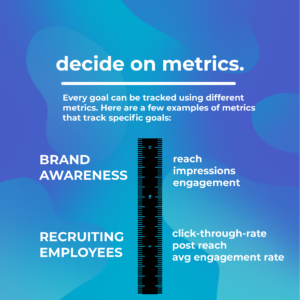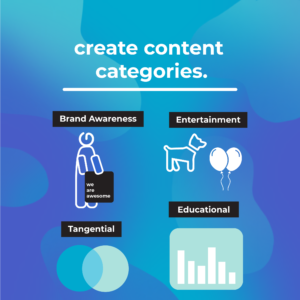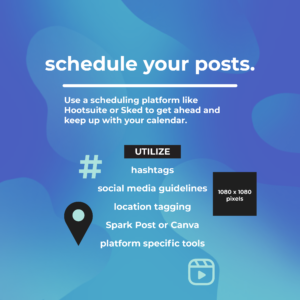Strategy vs Tactics
With more people than every following brands on social media, every business should have a social media strategy. This essential strategy should be thoughtful and specific to the business. When building a social media strategy it is important to understand the difference between strategy and tactics.
- A social media strategy is your long term plan for how you are going to achieve your social media goals.
- Tactics are the specific ways in which you will carry out that plan.
We’ll use an example of a small new bakery to help demonstrate the difference.
Their strategy is a 12 month plan that includes using social media to help build brand awareness in their community, securing 2 million in sales, and becoming a 5 star rated bakery.
Their tactics for carrying out this strategy include several specific methods. They will be forming a brand identity and curating social media posts that reflect their identity. They are also coming up with creative ways to engage with their online community. The bakery will be capturing local events on social media via tools such as live feed, reels, and stories. They are also setting up a Google my Business account, Yelp account, and optimizing their social media channels for ecommerce and ordering online.
As in the example, remember that strategy is the bigger picture, tactics are the detailed how-tos.
There are 7 basic steps to take when defining your social media strategy.

Define your goals.
Clearly define your business goals. Once that is done, you can create your marketing goals to support your overall business goals. These marketing goals should take into account the ways in which you want to communicate your offering to your audience.
Some marketing goals could include:
- Brand Awareness
- New Business
- Attracting Potential Employees
- Building a reputation as a thought leader in the industry

Define your target audience
There are many ways to sub-categorize your audience. Try creating brand personas. It is likely that you will have a few different target audiences. For example, non-profits usually have a donor audience, volunteer audience, and beneficiary audience.
The bakery we used as an example before may have the following audiences:
- Small to mid sized companies that need vendors for events
- Professionals needing a quick bite before work or on a lunch break
- Families with small children
- Those living in or around their zip code

Decide which metrics to use based on your marketing goals
Every goal can be tracked using different metrics. Some may overlap, but it’s important that you track what you’re doing so you can evaluate later what works and what doesn’t.
Here are a few examples of metrics that give meaningful insight to your specific goals:
- Goal: Brand Awareness
- Reach
- Impressions
- Share of Voice
- Engagement
- Brand Mentions
- Website Traffic
- Goal: New Business
- Customer Reviews
- # of new leads (people that reach out via website form, DM, directly to employees)
Goal: Attract Potential Employees
- Click-through-rate
- Post Reach
- Average Engagement Rate

Decide which social media platforms to use and what the target audience will be.
It’s not necessary to use all of them. Select the ones that you think are most relevant to your audience and focus on those. Make sure you set up business accounts in order to get access to analytics.
- Snapchat
- Vimeo
- Youtube
- TikTok

Determine content categories
Once you have your content categories, you’ll begin content creation. Content creation is when you start getting into the nit and gritty.
It’s helpful to start with your goals and create content categories around those.
Most relevant content categories include:
- Brand Awareness. Content that communicates who you are as an organization and why you do what you do. This regular content from this category will help users gain a clear picture of your brand identity. Pro tip: make sure your brand voice is consistent throughout your content, especially posts within this category.
- Entertainment. People like content that is intriguing and fun. Incorporate posts that are entertaining and maybe more casual. Content within this category will most likely overlap with brand awareness.
- Memes
- Team Lifestyle
- Dogs/Pets
- Office outings
- “Behind the scenes”
- Product/Service Offering. This is pretty straightforward. Tell your audience what you offer and provide a clear and easy path for them to secure that product or service. Pro tip: utilize ecommerce tools on instagram, facebook etc, and create CTAs that link directly to products or a schedule-an-appointment button. Linktree is a great way to have multiple links available for your followers.
- Tangential Content. Tangential content is content that does not directly relate to your organization but is still relevant to your audience. This content not only may reach others beyond your usual viewers, but it is helpful for SEO purposes and can provide variety to your posts.
- For example: A personal trainer may post something about “The best places in town to grab a healthy breakfast” or “My favorite parks to visit and unwind on my lunch breaks”.
- Educational/Informational. Depending on your audience, these posts can be really crucial to your social media plan. Content that makes users feel as though they learned something, or are reaching self actualizing truths are usually a win. Be sure to make this content very simple and easy to understand.
- Seasonal. Determine which special days are relevant to your organization and audience.
- Major holidays
- Organization anniversary
- Employee anniversaries, new hires
- National days (National Bosses Day, National Coffee Day)
- Timely events like Election Day, the 1-year anniversary of COVID-19 shutting down businesses

Create a content calendar with a tool such as Airtable
-
- The next step is keeping track of your social media plan. Use a content calendar tool to schedule everything out, make sure you are posting on a consistent basis, and prepare ahead of time. Calendars are also helpful if you are coordinating with multiple people on your team to push out content. When scheduling posts, take into consideration the highest traffic times on social platforms.
- Pro tip: Use this social media guide for best image sizes

Schedule posts in a tool such as Sked or Hootsuite (or manually post on planned dates)
Once you have your calendar built, you can start creating content and scheduling posts ahead of time. It’s better to get in front of things before it all sneaks up on you. Some platforms allow you to schedule stories and some do not — so assess your social media needs before you choose a scheduling platform.
- Utilize Canva or Spark Post to create posts with graphic elements
- Follow social media guidelines
- Utilize Hashtags
- Utilize Location Tagging
- Utilize the different tools that each social channel has to offer, for example, Instagram Guides, document posting on LinkedIn, etc.
Gray Digital Group is here to support your social media marketing needs. From developing a customized strategy, to writing engaging content, to executing the plan — as experienced industry experts, we’re here to help.
